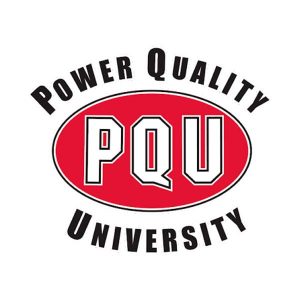Electrical harmonics pose considerable challenges in the industrial sector, affecting the reliability and efficiency of electrical systems.
These distortions in electrical voltage and current typically originate from non-linear loads that are increasingly prevalent in modern industrial environments.
Without proper management, harmonics can degrade the quality of the power system, leading to increased energy consumption, potential equipment malfunctions, and a significant reduction in the lifespan of electrical components.
The Fundamentals of Harmonics
In this Power Grid Podcast episode, we will dive deep into the fundamentals of electrical harmonics, identify the various problems they cause, and provide practical, effective solutions to mitigate their impact.
Drawing on the rich expertise of Brian Branigan, a seasoned professional with almost three decades in power protection products, this blog aims not just to inform but also to equip you with the necessary tools to combat harmonics in your electrical systems effectively.
Through detailed explanations, real-world examples, and expert insights, you’ll gain a robust understanding of how to maintain a stable and efficient power environment in your industrial operations.
What Are Electrical Harmonics?
Electrical harmonics are essentially distortions in the electrical current and voltage waves, typically occurring in power systems where non-linear loads dominate.
A linear load consumes current in a sinusoidal waveform that perfectly aligns with the voltage, which is not the case with non-linear loads.
These include a wide range of modern electronic devices, such as personal computers, variable frequency drives, and electronic lighting ballasts, which draw current in abrupt, short bursts, thereby disrupting the smooth sinusoidal wave of the electrical current.
The shift from linear loads to non-linear loads in industrial settings has marked a significant change, requiring adaptations in how equipment is selected, installed, and maintained.
Understanding these harmonics, their sources, and their effects is essential for maintaining an efficient and reliable power system.
Notably, the presence of harmonics can lead to inefficiencies and increased operational costs. For instance, excessive harmonic levels can cause overheating in electrical cables and machinery, which not only risks premature equipment failure but also raises safety concerns.
Additionally, as industries continue to integrate more sensitive electronic devices, the need for stringent harmonic mitigation strategies becomes even more critical to ensure stability and minimize interference in sensitive operations.
Problems Caused by Harmonics
Electrical harmonics can significantly impair the functionality and lifespan of equipment. Some of the common issues associated with harmonics include overheating of transformers and motors, failure of electronic devices, and inefficient power usage.
Specifically, harmonics lead to the phenomenon known as “eddy currents” in transformers. These currents generate excessive heat, which can damage the internal components of the transformer and reduce its operational lifespan.
In systems with significant non-linear loads, certain harmonic frequencies such as the third, fifth, and seventh are more prevalent.
These frequencies can create a complex scenario in power distribution, destabilizing the entire system and leading to unexpected downtimes and maintenance issues.

Mitigation Strategies for Handling Harmonics
Mitigating the effects of harmonics requires a two-pronged approach: understanding the type of equipment that produces harmonics and employing corrective measures to counteract their effects. Here’s how you can tackle harmonics effectively:
1. Harmonic Analysis and Power Quality Studies
The first step in mitigating harmonics is to conduct thorough power quality studies. These studies help in identifying the type and scale of harmonics present in the system. This data is crucial for choosing the right equipment that can handle or counteract the distorted currents and voltages.
2. Transformer Management
One traditional approach to handle harmonics has been to de-rate transformers or, conversely, use transformers with higher ratings than necessary (“oversizing”). This method compensates for the extra heat and energy loss caused by harmonics. Modern transformers are now designed to better accommodate switch mode power supplies, allowing for more efficient operation despite harmonic distortions.
3. Use of Harmonic Filters and Modern Technologies
Installing active harmonic filters and line reactors can significantly reduce harmonic distortions. These devices work by intercepting harmonic frequencies and either blocking them or smoothing them out before they can affect the rest of the power system. Newer technologies, such as harmonic conditioning units, provide comprehensive solutions by conditioning the power for all types of loads, thereby enhancing the system’s overall efficiency and reliability.

Real-World Applications & Measures
In practical terms, effectively managing harmonics requires proactive vigilance regarding the health of your electrical system.
Regular use of power quality meters is essential to monitor for any discrepancies or increases in harmonic levels that could signal potential issues.
It’s also crucial to maintain a consistent maintenance schedule to keep all components operating at peak efficiency. Adhering to standards such as NFPA 70B ensures that all equipment is appropriately tailored and robust enough to handle the challenges presented by non-linear loads.
This ongoing attention helps prevent equipment failure, enhances system reliability, and ensures operational safety, all of which are vital for minimizing downtime and maximizing productivity in any industrial setting.
Stay Proactive Against Harmonics
Ignoring the risks posed by electrical harmonics can lead to costly repairs and operational downtime.
By understanding the sources and effects of harmonics and implementing targeted mitigation strategies, you can protect your electrical systems from undue wear and promote a more stable, efficient power management environment.
For those in industrial settings grappling with power quality issues, reaching out for expert analysis and solutions is key.
Consult with power quality professionals who can provide tailored advice and solutions that match the specific needs of your systems. Harmonics don’t have to be a persistent problem—with the right knowledge and tools, their impact can be effectively managed and minimized.
Start Implementing Your Power Surge Protection Device Now
Power surges are bound to happen, so get ahead of the damage and get power surge protection devices to protect your investments!
Maintaining safe operations and protecting the well-being of those within your facilities is a priority.
At Power Protection Products, we can help you make informed decisions about quality surge suppression solutions tailored to the unique demands of your operation.






 01/09/2026
01/09/2026 9:00 am
9:00 am